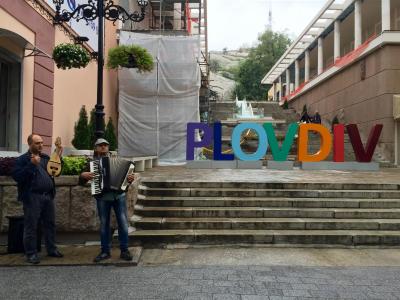So, what’s the deal with Plovdiv? Bulgaria’s second-largest city, and according to some, the country’s cultural capital, has had a long and complicated history. So long, in fact, that many sources site it as the oldest continually extant city in Europe. Despite its population of almost 350,000, the downtown has a small town feel (though, coming from several years in NYC, I may be biased). Like many parts of the Balkans, the number of residents has declined in recent years as people have migrated to other parts of the EU in search of more opportunities.
My favorite part of the city (and the favorite of tourists) is the Old Town. With its uneven and windy stone streets, steep hills, and enchanting old buildings, it is both easy and difficult to forget the thousands of years of conquest, everyday life, and destruction that have passed through. I may like the neighborhood less in winter if my pedestrian commute to and from AMTII (the acronym for the Academy of Music, Dance and Fine Arts) becomes icy and treacherous, which I imagine it could. But I think even that won’t detract from its charm. Immediately behind AMTII is the best view overlooking the ruins of an ancient Roman amphitheater, where there are still sometimes summer performances.
If you continue walking uphill from the Academy, it takes about 5 minutes to reach some Byzantine ruins. The ruins themselves are not quite as exciting as the view of Plovdiv is (and the view from this hill is not nearly as spectacular as that from Liberation Hill). However, on nice days it is a good spot to do some reading and writing, and I expect it would be a great place to see a sunset or have a picnic.
Down the hill to the west of the Old Town is the main pedestrian boulevard, lined with banks, stores, and street musicians. One sunny afternoon, while walking along a 500 meter stretch of the street, I passed an accordion/gadulka/tapan trio playing folk/wedding music, a big band playing jazz tunes, a violinist with a cat sleeping in his open case, a puppeteer with an amp and dancing marionettes, and another violinist, who was playing solo Bach. There was also a “human statue,” dressed all in yellow and holding a red rose.
Even more profuse than the street performers are the stray cats. There seem to be almost as many of them here as there are squirrels in the northeastern United States. Some of the felines wandering the streets look clean and well fed and may not be strays, but the majority are small and a little rough around the edges. I’m half-tempted to make a sub-blog called “Cats of Plovdiv” ;).
The side streets that branch off from the pedestrian boulevard host a large number of cafes, clubs, bars, restaurants, and smaller shops. There are several really nice cafes for reading/studying/writing/hanging out, and it is completely acceptable to order a drink and then sit for several hours doing work. A nearby neighborhood known as Kapana is reputably where the hip, young, creative folk hang out, but I haven’t spent much time there yet and so can’t share my verdict.
In the map to the right, you can see that Plovdiv is in the south-central part of Bulgaria, in a region called Thrace, which also includes parts of Greece and Turkey. In fact, it only takes 2.5 hours to drive to Komotini in Greece or 2 hours to get to the tip of Turkey (though it is 4.5 hrs by car to Istanbul). The Turkish border may become increasingly interesting over the next couple of months if more refugees choose to take that land route rather than going by boat to Greece. (And, if what happened yesterday is a sign, if political violence continues to escalate within Turkey itself.) Bulgaria’ geographic location has currently and historically placed it as an important locus of both conflict and exchange between different peoples and cultures.
Well, that’s all for now! Those of you who are wondering what on earth this kaval thing is that I am here to study don’t need to hold your breath much longer. Sometime this week I will try to give you a brief introduction to the instrument and its music.
